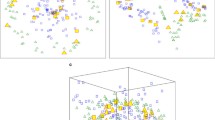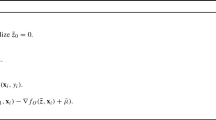Abstract
In binary classification, kernel-free quadratic support vector machines are proposed to avoid difficulties such as finding appropriate kernel functions or tuning their hyper-parameters. Furthermore, Universum data points, which do not belong to any class, can be exploited to embed prior knowledge into the corresponding models to improve the general performance. This paper designs novel kernel-free Universum quadratic surface support vector machine models. Further, this paper proposes the \(\ell _1\) norm regularized version that is beneficial for detecting potential sparsity patterns in the Hessian of the quadratic surface and reducing to the standard linear models if the data points are (almost) linearly separable. The proposed models are convex, so standard numerical solvers can be utilized to solve them. Moreover, a least squares version of the \(\ell _1\) norm regularized model is proposed. We also design an effective tailored algorithm that only requires solving one linear system. Several theoretical properties of these models are then reported and proved as well. The numerical results show that the least squares version of the proposed model achieves the highest mean accuracy scores with promising computational efficiency on some artificial and public benchmark data sets. Some statistical tests are conducted to show the competitiveness of the proposed models.









Similar content being viewed by others
Data availability
Enquiries about data availability should be directed to the authors.
Notes
The sources of data sets can be found here: https://github.com/tonygaobasketball/Sparse-UQSSVM-Models-for-Binary-Classification
References
Akyildirim E, Goncu A, Sensoy A (2021) Prediction of cryptocurrency returns using machine learning. Ann Oper Res 297(1):3–36
Arabasadi Z, Alizadehsani R, Roshanzamir M, Moosaei H, Yarifard AA (2017) Computer aided decision making for heart disease detection using hybrid neural network-Genetic algorithm. Comput Methods Programs Biomed 141:19–26
Bai Y, Han X, Chen T, Yu H (2015) Quadratic kernel-free least squares support vector machine for target diseases classification. J Comb Optim 30(4):850–870
Bazikar F, Ketabchi S, Moosaei H (2020) DC programming and DCA for parametric-margin \(\nu \)-support vector machine. Appl Intell 50(6):1763–1774
Calvo-Zaragoza J, Valero-Mas JJ, Rico-Juan JR (2017) Selecting promising classes from generated data for an efficient multi-class nearest neighbor classification. Soft Comput 21(20):6183–6189
Cherkassky V, Mulier FM (2007) Learning from data: concepts, theory, and methods. Wiley, London
Cortes C, Vapnik V (1995) Support-vector networks. Mach Learn 20(3):273–297
Dagher I (2008) Quadratic kernel-free non-linear support vector machine. J Global Optim 41(1):15–30
Devi RM, Seenivasagam V (2020) Automatic segmentation and classification of liver tumor from CT image using feature difference and SVM based classifier-soft computing technique. Soft Comput 24(24):18591–18598
Fayed HA, Atiya AF (2021) Decision boundary clustering for efficient local SVM. Appl Soft Comput 110:107628
Gao QQ, Bai YQ, Zhan YR (2019) Quadratic kernel-free least square twin support vector machine for binary classification problems. J Oper Res Soc China 7(4):539–559
Gao Z, Fang SC, Gao X, Luo J, Medhin N (2021) A novel kernel-free least squares twin support vector machine for fast and accurate multi-class classification. Knowl-Based Syst 226:107123
Gao Z, Fang SC, Luo J, Medhin N (2021) A kernel-free double well potential support vector machine with applications. Eur J Oper Res 290(1):248–262
Gao Z, Wang Y, Huang M, Luo J, Tang S (2022) A kernel-free fuzzy reduced quadratic surface \(\nu \)-support vector machine with applications. Appl Soft Comput 127:109390
Javadi SH, Moosaei H, Ciuonzo D (2019) Learning wireless sensor networks for source localization. Sensors 19(3):635
Javed AR, Shahzad F, Rehman S, Zikria YB, Razzak I, Jalil Z, Xu G (2022) Future smart cities requirements, emerging technologies, applications, challenges, and future aspects. Cities 129:103794
Ketabchi S, Moosaei H, Razzaghi M, Pardalos PM (2019) An improvement on parametric \(\nu \)-support vector algorithm for classification. Ann Oper Res 276(1–2):155–168
Luo J, Fang SC, Deng Z, Guo X (2016) Soft quadratic surface support vector machine for binary classification. Asia-Pacific J Oper Res 33(06):1650046
Luo J, Hong T, Fang SC (2018) Benchmarking robustness of load forecasting models under data integrity attacks. Int J Forecast 34(1):89–104
Magnus JR, Neudecker H (1980) The elimination matrix: some lemmas and applications. SIAM J Algebr Discrete Methods 1(4):422–449
Mohammadi N, Doyley MM, Cetin M (2020) A statistical framework for model-based inverse problems in ultrasound elastography. arXiv preprint arXiv:2010.10729
Mousavi A, Shen J (2019) Solution uniqueness of convex piecewise affine functions based optimization with applications to constrained \(\ell _1\) minimization. ESAIM Control Optim Calc Variat 25:56
Mousavi A, Rezaee M, Ayanzadeh R (2020) A survey on compressive sensing: classical results and recent advancements. J Math Model 8(3):309–344
Mousavi A, Gao Z, Han L, Lim A (2022) Quadratic surface support vector machine with L1 norm regularization. J Ind Manag Optim 18(3):1835–1861
Noble WS et al (2004) Support vector machine applications in computational biology. In: Vert JP, B Schoelkopf, K Tsuda (eds) Kernel methods in computational biology, computational molecular biology, MIT Press: London, pp 71–92
Pedregosa F, Varoquaux G, Gramfort A, Michel V, Thirion B, Grisel O, Blondel M, Prettenhofer P, Weiss R, Dubourg V, Vanderplas J, Passos A, Cournapeau D, Brucher M, Perrot M, Duchesnay E (2011) Scikit-learn: machine learning in Python. J Mach Learn Res 12:2825–2830
Qi Z, Tian Y, Shi Y (2012) Twin support vector machine with universum data. Neural Netw 36:112–119
Shen J, Mousavi A (2018) Least sparsity of \(p\)-norm based optimization problems with \(p>1\). SIAM J Optim 28(3):2721–2751
Shen J, Mousavi A (2019) Exact support and vector recovery of constrained sparse vectors via constrained matching pursuit. arXiv preprint arXiv:1903.07236
Singh SP, Dhiman G, Tiwari P, Jhaveri RH (2021) A soft computing based multi-objective optimization approach for automatic prediction of software cost models. Appl Soft Comput 113:107981
Sinz FH, Chapelle O, Agarwal A, Schölkopf B (2007) An analysis of inference with the universum. In: Proceedings of the 20th international conference on neural information processing systems, Curran Associates Inc., Red Hook, NY, USA, NIPS’07, pp 1369–1376
Stone M (1974) Cross-validatory choice and assessment of statistical predictions. J R Stat Soc Ser B (Methodol) 36(2):111–133
Vapnik VN (1998) Statistical learning theory. Wiley, Chichester
Vapnik VN, Chervonenkis AJ (1974) Theory of pattern recognition. Nauka, Moscow
Wang X, Fan N, Pardalos PM (2018) Robust chance-constrained support vector machines with second-order moment information. Ann Oper Res 263(1):45–68
Wang XY, Wang T, Bu J (2011) Color image segmentation using pixel wise support vector machine classification. Pattern Recogn 44(4):777–787
Weston J, Collobert R, Sinz F, Bottou L, Vapnik V (2006) Inference with the universum. In: Proceedings of the 23rd international conference on machine learning, pp 1009–1016
Xiao Y, Wen J, Liu B (2021) A new multi-task learning method with universum data. Appl Intell 51:3421–3434
Yan X, Zhu H (2023) A kernel-free fuzzy support vector machine with universum. J Ind Manag Optim 19(1):282
Yan X, Bai Y, Fang SC, Luo J (2018) A proximal quadratic surface support vector machine for semi-supervised binary classification. Soft Comput 22(20):6905–6919
Zhou ZH (2021) Machine learning. Springer, Cham
Funding
The work of H. Moosaei was supported by the Czech Science Foundation Grant P403-22-11117S and Center for Foundations of Modern Computer Science (Charles Univ. project UNCE/SCI/004). The work of M. Hladík was supported by the Czech Science Foundation Grant P403-22-11117S. The work of Z. Gao was supported by the Fundamental Research Funds for the Central Universities under Grant N2204017 and by the National Natural Science Foundation of China under Grant 72201052.
Author information
Authors and Affiliations
Contributions
HM was involved in conceptualization, supervision and methodology; AM was participated in conceptualization and methodology; MH took part in conceptualization; ZG contributed to software and validation; and all the authors are responsible for writing, reviewing and editing the manuscript.
Corresponding author
Ethics declarations
Conflict of interest
The authors declare that they have no conflicts of interest.
Ethical approval
This article does not contain any studies with human participants or animals performed by any of the authors.
Informed consents
Informed consent was obtained from all individual participants included in the study.
Additional information
Publisher's Note
Springer Nature remains neutral with regard to jurisdictional claims in published maps and institutional affiliations.
Rights and permissions
Springer Nature or its licensor (e.g. a society or other partner) holds exclusive rights to this article under a publishing agreement with the author(s) or other rightsholder(s); author self-archiving of the accepted manuscript version of this article is solely governed by the terms of such publishing agreement and applicable law.
About this article
Cite this article
Moosaei, H., Mousavi, A., Hladík, M. et al. Sparse L1-norm quadratic surface support vector machine with Universum data. Soft Comput 27, 5567–5586 (2023). https://doi.org/10.1007/s00500-023-07860-3
Accepted:
Published:
Issue Date:
DOI: https://doi.org/10.1007/s00500-023-07860-3




